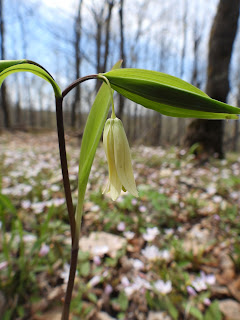Warm morning sunshine and a gentle breeze greeted us at the Lake Owen boat launch in the northwest bay. Two pontoon boats bobbed near the dock, captained by intrepid Museum volunteers. Participants of the Chequamegon Bay Birding & Nature Festival, held each year in late May, filed onto the pontoons and took their seats. Soon, we were off!
With Jane Weber, a Loon Watch educator on one boat, and me on the other, we were in search of loons. The first Loon Pontoon of the summer always contains an air of mystery – who will we find this year? How many territories will have nests? How many nests will produce chicks?
Within a few minutes, we’d already spotted one loon swimming near a tiny island. Suddenly, there were two! Loons have a way of just appearing out of nowhere. We delighted in watching the pair swim and dive calmly near the island while we talked about loon adaptations, ecology, nesting habits and more.
Just as we were about to continue on down the lake, a third loon landed nearby. The pair didn’t make a sound, but they did swim over to investigate. The three loons swam and dove in close proximity, calmly at first, and then with increasing signs of agitation. One of them stood up in the water, another flapped their wings. They dove and surfaced frequently. Then, suddenly, the intruding loon was off and running down the lake!
After we’d disembarked and I’d sent the participants back up to Ashland, Wisconsin, to meet their afternoon field trips, I drove over to Bibon Swamp. I didn’t get to lead a formal birding trip here this spring, but I still wanted to see who was singing.
The bee-buzz-buzz call of a golden-winged warbler greeted me the instant I opened the van door. I’ve written about these pretty little birds before – and the interesting ways that they are hybridizing with blue-winged warblers.
 |
| A golden-winged warbler photographed in the same area in 2021! |
Just a few steps down the gravel road, movement caught my eye – a flycatcher was darting out to catch insects and returning to the branch of a dead tree. This member of the Empidonax flycatcher family is difficult to identify just by sight. The group all looks pretty much the same with grayish-olive backs and whitish underparts. Their voices are distinctive, though! Flycatchers’ songs are innate, not learned, and are standard within each species. I waited a while, but this little guy didn’t sing me his name, so I walked on.
 |
| Flycatcher |
A flash of red caught my eye, and I found a rose-breasted grosbeak swinging from a treetop. He wasn’t singing but looked pretty snazzy. Glancing down, I found a patch of fiddlehead ferns just perfect for picking. With my hands full, I walked back to the van. In the grassy roadside, a monarch butterfly – my first of the season! – nectared on a dandelion.
 |
| Monarch Butterfly |
The repeated, robin-like phrases of a red-eyed vireo intensified above me in a grove of balsam poplars, so I decided that I’d try to spot him instead of just listen. Amazingly, I did find the little crooner despite the thicket of leaves already almost full size. After several tries, I captured a photo of him with his mouth wide open, singing one of his 20,000 songs for the day.
Back out in the sunshine, buzzing near the ground drew my attention to a fat common eastern bumble bee queen out gathering supplies for her new nest. A shiny blue blister beetle nibbled pollen from a strawberry blossom nearby. Just when I’d decided it was time to leave, the distinctive “Quick! Quick! Fire! Fire! Here! Here!” of an indigo bunting made me stare unproductively into the trees looking for his iridescent blue.
 |
| Blister beetle on strawberry blossom |
After hurrying back to the van, I met another group of participants at the turnoff, and led them to the North Country Trail Hardwoods State Natural Area. Here, we spotted large-flowered trillium, nodding trillium, the starry yellow flowers of blue-bead lily, and one bedraggled looking spring beauty almost finished with their life cycle for this season.
 |
| Large-flowered trilliums were in full bloom! |
 |
| Nodding Trillium |
.jpg) |
| Blue-bead lily |
 |
| Spring beauty: Spring continues to speed along. Not long ago the first spring beauty bloomed, and already the last blossom is fading. Photo by Emily Stone. |
 |
| Pale Corydalis |
As I wrote before, spring moves quickly! Already, the world feels filled to the brim with colorful new life. My day outside was truly a festival of birds and nature! The official Chequamegon Bay Birding & Nature Festival will be over by the time you read this but make a note for next April to register for the 3-day event filled with field trips and presentations at https://www.birdandnaturefest.com/! And for photos of all of the birds and plants mentioned above, visit this article on my blog.
Emily’s award-winning second book, Natural Connections: Dreaming of an Elfin Skimmer, is available to purchase at www.cablemuseum.org/books and at your local independent bookstore, too.
For more than 50 years, the Cable Natural History Museum has served to connect you to the Northwoods. The Museum is open with our brand-new exhibit: “Anaamaagon: Under the Snow.” Our Summer Calendar of Events is open for registration! Follow us on Facebook, Instagram, YouTube, and cablemuseum.org to see what we are up to.




.JPG)

.JPG)
%20Alaska.jpg)

















